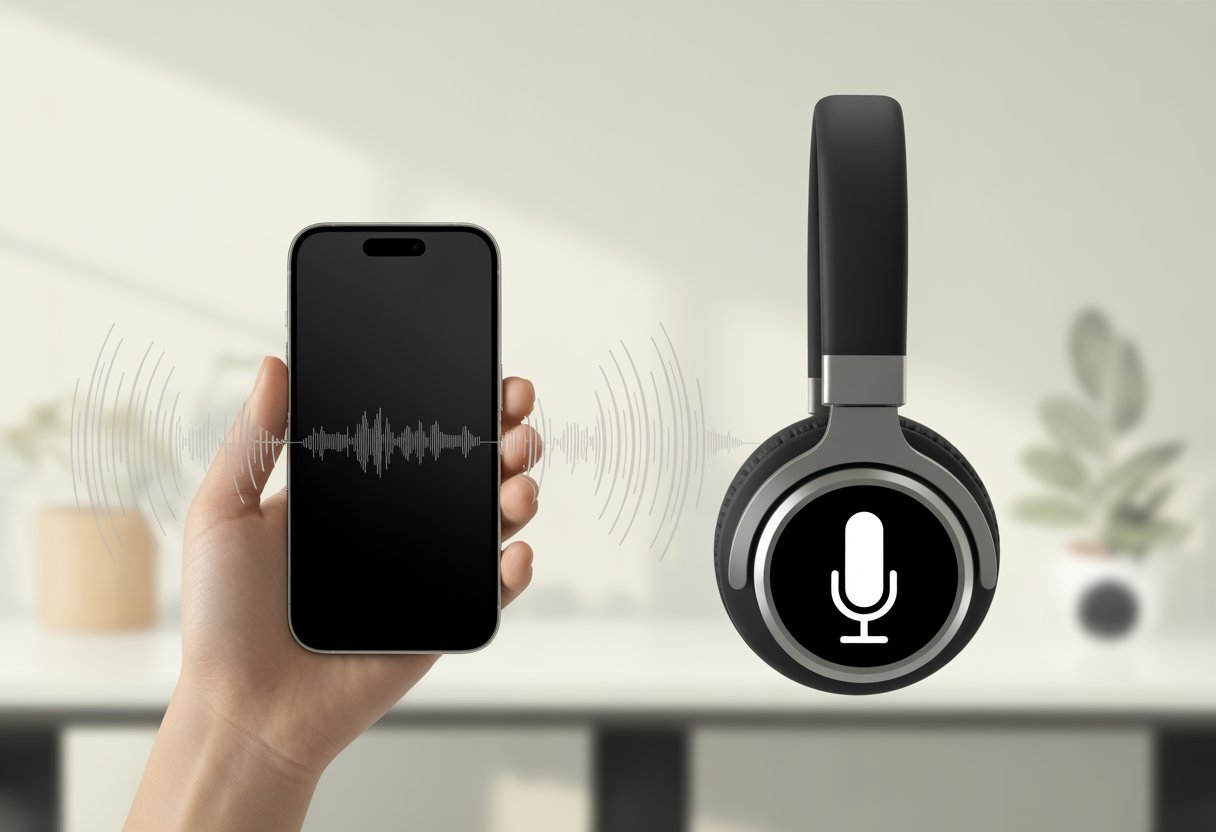We’ve all been there—leaning back in our chairs, feeling on top of the world with our Bluetooth headphones, then suddenly realizing we need a mic for a call or recording.
No need to scramble for that old wired headset anymore. We can actually use our Bluetooth headphones as a microphone and save ourselves a lot of untangling and frustration.

Honestly, some days using tech makes us question every life choice. But making our Bluetooth headphones double as a mic doesn’t need to be one of those struggles.
It’s easier than you might think. With a few quick steps, we can connect and sound pretty clear—well, as clear as Bluetooth allows.
Here’s what’s really happening behind the scenes (and in our ear canals), plus how to pull it off without needing a degree in rocket science.
Just a heads-up: we probably won’t get studio-quality audio when using both the mic and headphones at the same time—Bluetooth has its limits.
Still, with a little know-how, we can chat, play, and record with one handy gadget. Let’s get into how to make this everyday magic happen and keep our gadgets (and social lives) wireless.
Understanding Bluetooth Headphones and Microphones
Using Bluetooth headphones as a mic isn’t just about flipping a switch and hoping for the best. We want crisp calls, clear sound, and, if possible, fewer awkward tech fails in front of friends or coworkers.
What Makes a Bluetooth Headset Different?
Most of us assume all Bluetooth headphones are the same, but that’s like saying all dogs are Chihuahuas.
A Bluetooth headset is usually designed for voice calls first. These devices often have one ear pad and a boom mic sticking out by our mouth, making us look a bit like mission control at NASA.
Bluetooth headphones, on the other hand, are usually over-the-ear or on-ear, built more for music and comfort. They still have a built-in microphone, but it’s not always in the best spot for voice clarity.
Headsets connect quickly for calls, but our regular headphones might make us sound like we’re calling from inside a tunnel.
Here’s a quick breakdown:
| Device Type | Mic Placement | Best For |
|---|---|---|
| Bluetooth Headset | Near mouth (boom) | Calls, meetings |
| Bluetooth Headphones | On ear cup | Music, casual use |
The Role of Built-in Microphones
Let’s be honest: the real star here is the built-in microphone hiding somewhere on our headphones.
For most Bluetooth headphones, the mic is tiny and sits either on the ear cup or along the edge. This design is super convenient for hands-free chatting, but it also means the mic will pick up more of our surroundings—like loud siblings or barking dogs.
Headsets with boom mics block out background noise better. Regular Bluetooth headphones do okay for quick calls, but for gaming, streaming, or important meetings, some of us might end up sounding like we’re narrating from a fish tank.
For most basic needs, using the built-in mic is usually fine. Want to see this in action? Here’s a video showing how to use your Bluetooth headphones as a microphone.
Bluetooth Versions and Audio Quality
Let’s talk Bluetooth versions—the part nobody ever reads in the manual.
Bluetooth 5.0 and above give us better range, more stable connections, and smarter pairing. If our headphones use an older Bluetooth version, we might notice more lag or lower sound quality, especially when using the mic.
A weird quirk: sending good quality music and sending our voice at the same time is tough for Bluetooth. Many headphones switch to a lower audio quality mode (called “hands-free” mode) when we turn on the mic.
That’s why sometimes our favorite playlist suddenly sounds like it’s underwater during a call. More about why this happens can be found in this Reddit thread.
For the best call experience, we want newer Bluetooth versions and headphones designed for both calls and music. Otherwise, we might have to pick between hearing our friends or actually sounding like ourselves.
Setting Up Bluetooth Headphones As a Microphone on a Computer
If our Bluetooth headphones want to chat with our computer, we need to give them a proper introduction.
Different operating systems have their own quirks, and sometimes things just don’t work right away. But with a little patience (and maybe some coffee), we can get everything working together.
Windows Setup Steps
First, let’s make sure we’ve paired our Bluetooth headphones with our Windows computer.
Head over to Settings > Devices > Bluetooth & other devices and connect our headphones. If they show up in the device list, that’s a good sign.
Next, open Control Panel > Hardware and Sound > Sound. Under the Recording tab, we should see our Bluetooth headphones’ mic pop up (sometimes called “Hands-Free”).
Click it, then hit the Set Default button. Voilà—or at least, that’s the idea.
When we use the mic, audio quality drops. That’s just a normal Bluetooth “feature” because the connection doesn’t like juggling both high-quality sound and a mic signal at the same time.
If we want both at once, Bluetooth just isn’t built for that.
Configuring Bluetooth Headphones on macOS
On a Mac, the process is a little different but sometimes just as stubborn.
Start by opening System Preferences > Bluetooth and connecting our headphones. Once paired, go to System Preferences > Sound.
Click the Input tab and select our Bluetooth headphones from the list. Make sure the input volume is set to a reasonable level.
Testing 1-2-3!—if the input meter jumps when we talk, we’re in business.
Just like on Windows, we might notice our sound quality drops while the mic is active. Bluetooth on Mac still struggles to multitask.
If we need clear audio and a mic at the same time, the Mac’s internal mic might be less picky.
Troubleshooting Mic Not Working
Still not working? Don’t toss the headphones just yet.
Let’s double-check that our headphones actually have a built-in mic. You’d be surprised—some only do sound.
If we’re sure, but still getting silence, try unpairing and repairing the device. Turning Bluetooth off and on again is a classic tech move.
On Windows, visit the Sound settings to check if the mic is muted or disabled. On Mac, confirm it’s selected as our input device.
Sometimes an old or missing driver causes problems—check for driver updates.
Remember, using Bluetooth headphones as a mic can limit stereo sound quality. Wired solutions or the Mac’s internal mic might spare us the headache.
If all else fails, give the headphones a break and use a backup mic that’s always in a chipper mood.
Using Bluetooth Headphones As a Microphone for Laptops and Other Devices
We all want our Bluetooth headphones to pull double duty—playing our favorite songs and letting us talk to people without shouting at our laptops or waving phones around like TV antennas from the ‘90s.
Figuring out how to use a Bluetooth headset as a microphone isn’t rocket science, but it does take a few careful steps and menu clicks.
Laptop Connection and Sound Settings
Let’s make sure our laptop and Bluetooth headphones actually know each other.
Activate Bluetooth on the laptop, then put the Bluetooth headset in pairing mode. If things work out, the headset should pop up on our list of available devices—kind of like a secret club that only involves us and our headphones.
Once paired, the real challenge is finding the right sound settings.
Open the Sound Settings by right-clicking the sound icon and clicking “Open Sound settings.” Under the Input section, we’ll usually see our Bluetooth headphones as an option if the internal mic hasn’t stolen all the spotlight. It might show up as “Hands-Free AG Audio” or something equally fancy.
Don’t panic if the audio quality drops when we enable the mic. Bluetooth can get a little overwhelmed trying to deliver both high-quality stereo sound and microphone input at the same time.
For a quick upgrade, we can use the headphones for calls and then switch back to stereo mode for music. More details on how others tackle this are on the Reddit PC gaming support forum.
Pairing with Phone Systems
Let’s talk phones. Pairing our Bluetooth headset with a smartphone is usually easier than explaining to our grandma what Bluetooth is.
Open the phone’s Bluetooth menu, select the headset, and wait for the little chirp or light that means we’re connected.
When we make calls, our phone usually uses the Bluetooth headset’s microphone automatically. Some devices ask us politely (with a popup) what audio source we want.
If we’re switching between the internal mic and the Bluetooth headset during calls, most phones let us tap a button to swap sources—no gymnastics required.
For video calls or voice messages, most apps use the headset when it’s connected. If our phone ignores us and sticks with its internal mic, a quick toggle of the Bluetooth setting or restarting the app usually fixes it.
As long as we don’t sit on our headphones or feed them to the dog, we should be set for hands-free, wireless chatting.
Enhancing Your Bluetooth Microphone Experience With Software
Before we toss out our Bluetooth headphones in frustration, let’s talk about some smart ways to make things sound a lot better.
We can use software tricks to fix muffled audio, boost our microphone, and avoid sounding like we’re calling in from the bottom of a swimming pool.
Optimizing Audio Input for Skype for Business
Microsoft’s Skype for Business is famous for meetings, long emails… and sometimes making us sound like robots when using Bluetooth headphones.
The issue usually comes from how the program picks the audio input.
First, check the audio device settings in Skype for Business:
- Click the gear icon (don’t worry, it won’t bite)
- Open “Audio Device”
- Make sure our Bluetooth headphones are picked for both Microphone and Speaker
If our mic still sounds terrible, blame the Bluetooth profile. Most Windows PCs love switching our fancy headphones to a “telephone quality” mode called Hands-Free Profile (HFP), which makes our voice sound like static-filled walkie-talkie.
Some tricks include:
- Unpair and Repair: Yes, like relationship advice. Disconnect and reconnect our headphones to force the PC to recognize the right settings.
- Keep Audio Out Separate: If possible, use the headphones just for the mic, but hear sound through other speakers. It’s weird, but it helps.
Third-Party Software Solutions
When built-in settings let us down, third-party software can really save the day. Programs like VoiceMeeter let you pick your microphone and speaker profiles, and you can blend audio inputs for better sound.
You might want to try Equalizer APO if you want to sharpen your mic input. It gives you a bunch of ways to tweak your audio, like adding filters or boosting the volume so your voice actually sounds like you.
Here’s a quick table of handy software you might want to check out:
| Software | What It Does |
|---|---|
| VoiceMeeter | Advanced audio mixing and routing |
| Equalizer APO | Detailed sound equalizer for mic |
| Krisp | Removes background noise from calls |
No matter which one you pick, spending a little time on setup can make your Bluetooth headphones work way better as a mic. Your coworkers might even thank you for not sounding like you’re underwater. If you want a visual guide, here’s a YouTube walkthrough that covers using Bluetooth headphones as a mic on PC.
Solving Common Issues and Communicating Like a Pro
Let’s be real—using Bluetooth headphones as a mic isn’t always smooth. Stuff breaks, and it’s usually at the worst time.
Our goal? Help each other push through these annoying issues and keep our communication clear.
Email Troubleshooting Support
If your headset mic suddenly dies in the middle of a big Zoom call, it’s easy to panic. Try not to blast support with a one-word subject like “HELP.”
Instead, make your email count by including a few details:
- The model of your Bluetooth headphones
- The Bluetooth version on your computer (like Bluetooth 4.2 or 5.0)
- A clear description of the problem (“mic not picking up sound,” “audio keeps cutting out,” etc.)
- Steps you’ve already tried (like restarting things)
Attach a screenshot of any error messages if you can. Support teams love that sort of thing.
If your headphones work fine with other devices, mention that too. It helps support skip the guessing and get right to the fix.
You’ll get better answers when you give the right info up front. If you want more tips, here’s a list of common Bluetooth headphone mic fixes.
Maintaining Connection Quality
Good Bluetooth connections are a lot like friendships—they only work if you stick close. If your headphones cut out in the middle of a sentence, you probably just wandered too far from your computer.
Try to keep devices within 30 feet. Thick walls? Yeah, those can ruin your signal fast.
Bluetooth versions make a difference too. You’ll usually get clearer sound and mic quality by pairing newer Bluetooth headphones with a computer that supports the latest Bluetooth version.
But even with shiny new tech, things can go sideways if your wireless environment is packed. If you want fewer dropouts, just turn off any Bluetooth gadgets you’re not actually using.
Here’s something a lot of people don’t realize: Bluetooth headsets can’t really deliver both great sound and full mic use at once. The moment you switch the mic on, your headphones might suddenly sound like an old telephone (seriously, it’s not you, it’s Bluetooth). If you’re curious about the technical details, check out this discussion of Bluetooth headset audio limitations.
And hey, before you assume your headphones are possessed, try updating your drivers. Give your computer a good old reboot.
Sometimes, “have you tried turning it off and back on again?” actually works.
- Why do my Bluetooth headphones keep resetting? Solving the Mystery of Rebooting Ears - January 5, 2026
- Is WHOOP Worth It for Runners, Cyclists, and Weightlifters or Just Another Expensive Wrist Buddy? - January 5, 2026
- Best Fitness Trackers Under $200 That Won’t Make Your Wallet Sweat - January 4, 2026






